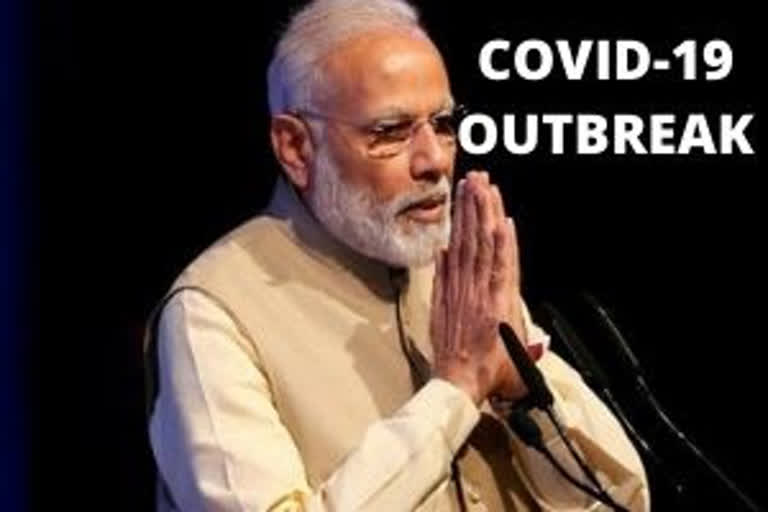New Delhi: The government's containment strategy regarding the dreaded COVID-19 virus appears to be working. When one compares India's position vis-a-vis G7 nations, the curve seems to be flattening out.
The only immediate concern now is the community transmission which may have taken place due to the Tableegi Jamaat congregation in mid-March in Delhi's Nizamuddin area. Impact assessment and threat percept of this is being done continuously for the enormity of what may have happened is being prognosticated and reined in with quick action sequestering of such carriers in different parts of India.
Prime Minister Narendra Modi has from the beginning been assiduously driving the entire monitoring action plan and implementation programme on the virus.
Almost since as early as January 25, he voiced concern over the impact of the virus and has been in touch with the ministry of health to track it with a great degree of reliability not just globally but domestically. Modi had rightly pointed out that the virus could leave a trail of death behind. And its debilitating impact has been seen in China, European countries, Iran and the US as well.
From early February, the PM took over the reins on testing, overseeing the flights to pick up stranded Indian students in Wuhan, similar operations to evacuate Indians in Iran, Italy or even offer aid to Maldives. The bottom line at all times being to minimise damage due to the virus in India.
Also read: COVID-19 LIVE: 57 fresh cases in Tamil Nadu, 4 in Rajasthan, 5 in Bihar reported today
Old school Indic style of a lockdown, closing air space, trains et al were part of this gargantuan exercise to ensure that there is no community transmission of the virus given the density of our population.
As the crisis grew in China and then spread dramatically to Italy and other European nations and emerged in the US too with devastating effect, the PM decided to use a mix of tactical actions working in conjunction with a longer term vision to bring relief to India. Not only did he take the lead with the video conferencing summit with SAARC nations, but he participated in the G20 deliberations using the VC facility.
Equally he declared a ‘Janata Curfew' on a Sunday, March 22, so that the populace wouldn't panic and then after assessing what happened that day took a series of determined measures to lock down India.
At all times, he advised his core team about two issues - India's demographic mix and more importantly our geographical proximity to China. While he created 11 empowered groups to deal with the crisis more recently, his core team which has interfaced with him constantly since the outbreak has enabled him to be on top of the situation from the outset.
Led by Principal Secretary P K Mishra, Cabinet Secretary Rajiv Gauba, Health Minister Harshvardhan, DG ICMR Balram Bhargava, Health Secretary Priti Sudan, Niti Aayog member - planning Dr Vinod Paul and Prof K Vijay Raghavan, principal scientific adviser to PM, this focus group reports directly to the PM, even as the empowered groups execute his vision. This core team aids PM in taking key decisions.
A panel of noted medical experts led by AIIMS director Dr Randeep Guleria and Dr Raman Gangakhedkar, head of ECD at ICMR is assisting the core group in disseminating and understanding the macro and micro problems related to the virus in India.
Based on minute to minute technical data. Equally mathematical modelling of the virus is being done. The empowered groups constituted under the Disaster Management Act 2005 are specific groups which look at specific issues for smoother government facilitation at all levels. There is no war room per se, but a set of key personnel assisting the PM in this vital task.
Take the Office of Principal Scientific Adviser, Prof K Vijay Raghavan which issues manuals on homemade masks: Masks for Curbing the Spread of SARS-CoV-2 Coronavirus. An office memorandum allowing institutes under DST, DBT, CSIR, DAE, DRDO and Indian Institute of Science (IISc) to self assess and prepare their labs for research and testing through the standard and rigorous protocol.
Also read: Global COVID-19 tracker
Specifics have been gone into so that the granularity of the concentric circle leaves nothing to chance. Testing will be stratified according to priorities set by the Ministry of Health and Family Welfare (MoHFW) and ICMR. Research will also be stratified into short and mid-term returns. Analyses show that if 50 per cent of the population were to wear masks, only 50% of the population would be infected by the virus. Once 80 per cent of the population wears a mask, the outbreak can be stopped immediately.
Or for instance why it is imperative to wear a mask?, it is believed that "COVID-19 virus spreads easily from person to person contact. Virus carrying droplets dry fast enough to form droplet nuclei and remain airborne eventually landing on different surfaces. SARS-CoV-2, the virus that causes COVID-19, has been detected in aerosols for up to three hours and on plastic and stainless steel surfaces for up to three days."
Tasked with specific responsibilities, they have the power and autonomy to roll out decisions on livelihood, logistics, testing kits, quarantine and what have you with the PM personally monitoring and overseeing every aspect. The interesting thing is that these actions have got a very strong buy in from India's polity and state chieftains as well.
The medical emergency management plan, availability of hospitals, isolation and quarantine facilities, ensuring availability of essential medical equipment among other things is under the supervision of these empowered groups. (IANS report)



